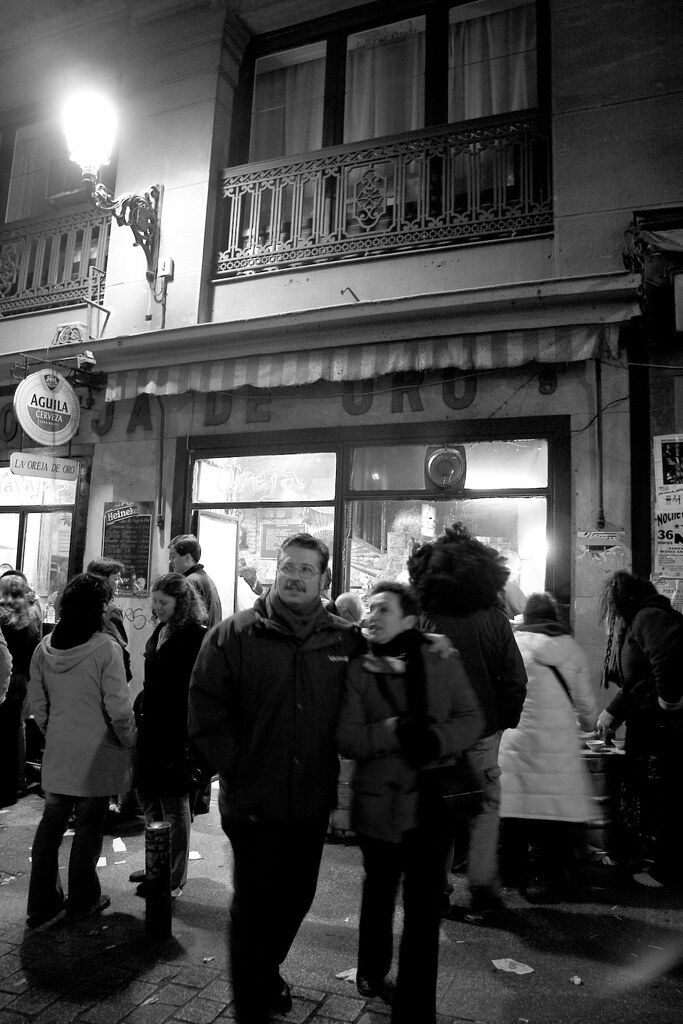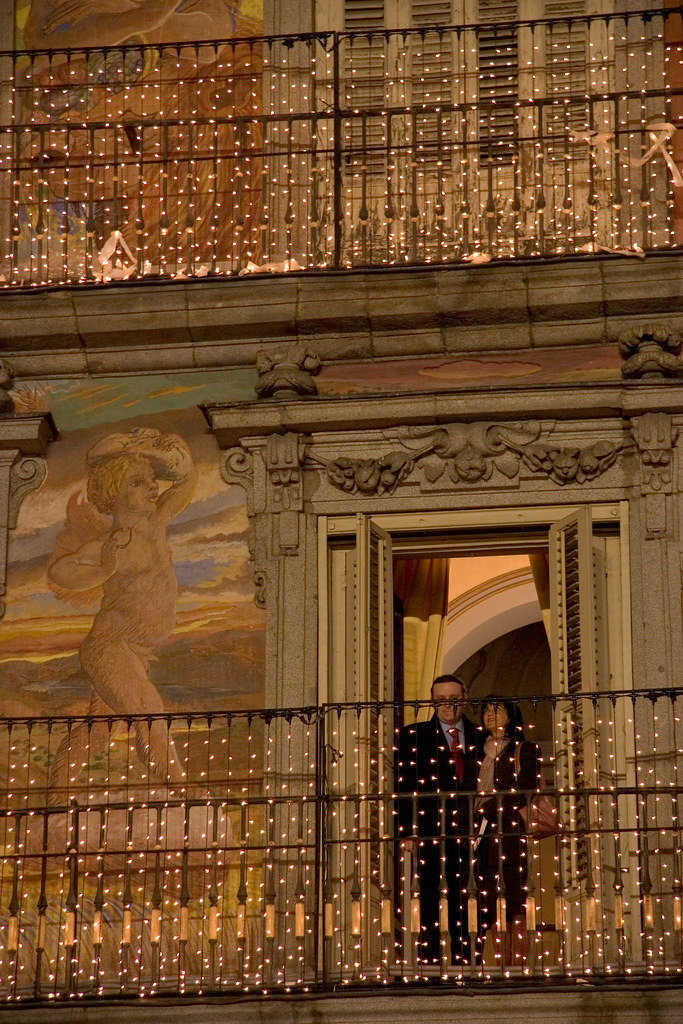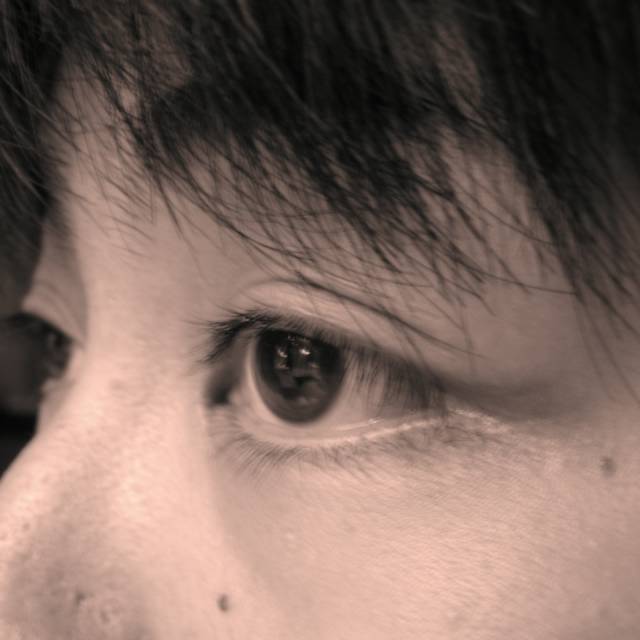Although its appeal felt slightly faded after coming back from the epicurean country of Basque, we found Madrid with a great range of tapas bars to offer. One of the convenient clusters of tapas bars scattered across the city is the Santa Ana area, about five minutes walk from the tourist-and-pickpockets-filled Puerta del Sol. On our third night, which we inadvertently spent in Madrid waiting for our backpacks that disapperaed during the flight in, we went to the Santa Ana district for a night of tapas-bar hopping.
 Figure A: Spaniards hapily tapas-hopping in Santa Ana.
Figure A: Spaniards hapily tapas-hopping in Santa Ana.The streets were literally filled with people overflowing from busy bars (Figure A). Smell of garlic (a Spanish staple) being fried in abundant olive oil (another staple) floated in the crisp yet welcomingly warm night air of mid-December. We headed to a tapas bar, which, according to my reliable companion's "Rough Guide to Spain," specialized in sea food to kick off our night. The place, despite its fluorescent-lit drabness, was packed with local customers mainly in their forties and fifties. A good sign. We squeezed in to get a narrow stretch of the counter and ordered a portion of gambas al ajillo (small shrimps cooked in garlic-scented olive oil in a small clay pan) and patatas bravas (fried wedges of potatoes smothered in spicy red sauce, my favorite dish from the last visit to Spain). The shrimps were ever so tender and sweet in themselves, and the bravas sauce impressed my companion, who delightedly wiped off all the piquant sauce with a piece of bread that came with the order. Drinking our Mahou beer (a rather nondescript beer ubiquitously found in Madrid), we looked around the busy establishment. Wisps of gray hair sticking out from a worn-out brown hunting cap of a working-class man, oily shells of shrimps (with tiny legs still attached to them) scattered on the tile floor, cheap paper napkins being passed from hand to hand--the place felt "authentic," which is often an euphemism for the mundane, even slightly shady drabness, but not this time. After eyeing at a few sticks of roasted meat on someone's plate behind my companion, we ordered two (by pointing fingers at them). It turned out to be pincho moruno, seasoned and roasted lamb. Very tasty. As we attack our lamb sticks, the place became even more crowded. There were people everywhere, waiting for a space to squeeze in. We decided that it was time to leave for another bar. The bill came out to be thirteen euros for shrimps, potatoes, two skeweres of roasted lamb and two beers. Great.
After spending some time in the greasy, smokey, stuffy environment, the night air felt wonderfully fresh. As we wandered in the star-ceilinged streets, we noticed that we were very thirsty--despite the beer we just had in the bar. With some notable exceptions in the Basque region, Spanish tapas are on the extremely salty side--sometimes excruciatingly salty--possibly in order to increase the sale of beverages. (Yet, alcoholic beverages are insanely cheap. For example, you can get a glass of beer for a euro, a small glass of hard cider for 80 cents.)
This time, we decided to put the guide away and sniff our way to the next tapas bar. Wherever smells good, must tast good. Plus, we could easily judge the good ones by the degree of "packed-ness," for it was hitting the prime bar-hopping time (which means it was around 10 pm--Spaniards are late eaters). Thus, following the guidance of our reliable noses and judging from the packed-ness index, we decided on Freiduria Rocio for the next stop (figure B).
 Figure B: Freiduria Rocio, a tapas bar specializing in various forms of mussles.
Figure B: Freiduria Rocio, a tapas bar specializing in various forms of mussles.This place was even more crowded than the last one--we couldn't get a space along the counter, which is usually the best place to occupy, in terms of the proximity to the bartenders and the ease of ordering things whose names we don't know by pointing at them. We squeezed ourselves next to a narrow, greasy wooden board protruding from the back wall, which worked as an additional counter space. Behind the counter, a bolding Spanish bartender (who appears in the above photo, proudly displaying his steamed mussles) and a Latin American cook were working like two frenzied hamsters in a fast-spinning wheel. Quickly looking around, we set our minds on a plate of mussle shells stuffed with something mysterious, breaded, and deep-fried. A group of young women were devouring these piping-hot creations one by one, using tiny spoons and smiling at each other in satisfaction. Those gotta be good.
After a few minutes of awkward attempts, I finally got the attention of the Latino cook (who was very sweet to us linguistically challenged) and asked for the fried shells. The guy grabbed six from a refregerater and threw them in the deep frier. Soon, an appetizing aroma of hot grease and spicy blend of seasonings started to tickle our nostrils. Then the cook picked them up from the frier, mounted them in a plate and handed it to me, saying "Tigres!" We dipped our tiny spoons into the soft filling in the shiny mussle shells, breaking the crunchy cover of bread crumbs. Inside was a mixture of bechamel sauce, spicy tomato sauce and chopped-up meat of the mussles heavenlily mingled together to create a dangerously hot, decadantly creamy mass of obscene calories, sodium and cholesterol. But who cares? We didn't come all the way to Spain to "eat right." So, we ploughed through these little "tigers," soothing our fiery (fiery from the heat, saltiness, and spiciness) mouths with gulps of beer. Six large shells of stuffed mussles came for a mere 4 euros.
Our coats had started to smell of grease by this time--but we weren't done yet. My gluttonous companion demanded for one more tapa. Though the angel on my right shoulder whispered no, her voice was obliterated by the devil that was my insatiable palate. We paid the bill and head out, making our way through the tight-packed crowd like an appetite-driven Moses.
[to be continued]





